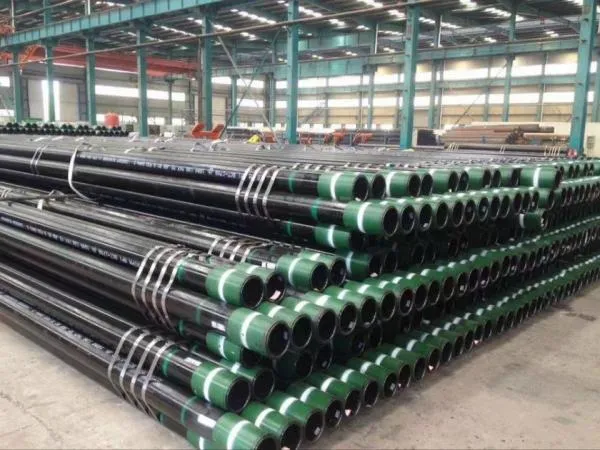In the world of oil extraction, the size of oil well pipe casing plays a vital role in ensuring the integrity and efficiency of the drilling process. Oil well casing refers to the cylindrical pipe installed in the oil well to stabilize and seal the wellbore, prevent the surrounding formation from collapsing, and control the flow of fluids in and out of the well. Understanding the basic size range of oil well casing is essential for engineers and operators in the oil and gas industry.
Oil well pipe casing is usually classified according to its nominal outside diameter (OD) and standardized to suit specific drilling and completion requirements. The standard sizes of oil well pipe casing range from relatively small diameters suitable for shallow wells to larger diameters used for deeper and more complex drilling operations.
At the lower end of the range, oil well pipe casing sizes usually start at around 4 1/2 inches in diameter. This size is common for wells drilled at relatively shallow depths and is suitable for many initial drilling stages. As drilling depths and complexity increase, larger casing sizes are required to accommodate higher pressures and larger diameter drilling tools.
Going up in size, 5 1/2 inches is another standard diameter for oil well pipe casing. This size is frequently used in shallow and deep wells, providing a balance between structural integrity and ease of drilling operations. It provides ample space for installing production tubing and other completion equipment while maintaining the strength required to withstand downhole pressures.
For deeper wells and more demanding geological conditions, oil well pipe casing sizes can extend to 7 inches and above. These larger diameters are essential for wells that encounter higher pressures, harsher downhole environments, or require extensive completion equipment. The robustness of the larger casing sizes ensures that the wellbore remains stable and secure throughout the drilling, completion, and production phases.
Converting between these different casing sizes requires careful planning and engineering expertise. Each size increment must be compatible with the previous casing string and effectively seal the wellbore to prevent any fluid migration or well integrity issues. Engineers must select the best casing size for each section of the wellbore, taking into account factors such as well depth, formation characteristics, expected pressures, and the specific requirements of the drilling operation.
What are Oil Well Pipe Casing Sizes?
The size of oil well pipe casing is specified by its outer diameter and wall thickness. These sizes are often standardized to American Petroleum Institute (API) standards. Common oil well pipe casing sizes range from 4 1/2 inches to 20 inches OD, with varying wall thicknesses to accommodate different well depths and pressure requirements.
For example, a common OCTG casing size might be designated as a "7" (7.00 inches OD) with a specific wall thickness in pounds per foot or millimeters. The exact size and specifications of the casing depend on the specific drilling conditions, well design, and regulatory requirements for the oil and gas operation.
Oil well pipe casing dimensions

Specifications of oil well pipe casing
|
Product name
|
|
|
Process
|
Hot rolled and cold drawn
|
|
Standard
|
API 5L, API 5CT, ASTM A106/A53, ASTM A519, JIS G 3441, JIS G3444, JIS G3445 DIN 2391, EN10305, EN10210, ASME SA106, SA192, SA210,SA213, SA335, DIN17175, ASTM A179
|
|
Our diameter
|
1/8 – 30 inch (10.3-762mm)
|
|
Wall Thickness
|
0.049” – 2.5” (1.24- 63.5mm)
|
|
Length
|
Random Length, Fixed Length, SRL, DRL
|
|
Steel Grade
|
API 5L: GR B, X42, X46, X56, X60, X65, X70
ASTM A53/A106: GR A, GR B, GR C
ASME SA106: GR.A, GR.B, GR.C
ASME SA192: SA192
ASME SA209M: T1, T1a
ASME SA210: GR.A-1, GR.C
ASME SA213: T2, T5, T9, T11, T12, T22
ASME SA335: P2, P5, P9, P11, P12, P22, P91
DIN17175:ST35.8, ST45.8, 15Mo3, 13CrMo44
|
|
Surface
|
Fusion Bond Epoxy Coating,Coal Tar Epoxy,3PE,FBE,Varnish coating,Bitumen coating,Black Oil coating as per customers requirement
|
|
Treatment
|
Heat treatment:Annealed: Bright annealed,Spheroidize annealed, Normalized, Stress relieved, Cold finished, Quenched and Tempered.
|
|
Application
|
Applicable to the general structure, mechanical structure, water wall panel, economizer, super heater, boiler and heat exchanger
with seamless steel tubes, and to transport liquid, gas, oil etc.
|






 English
English Español
Español بالعربية
بالعربية












 Phone :
Phone :  Whatsapp :
Whatsapp :  Email :
Email : 


